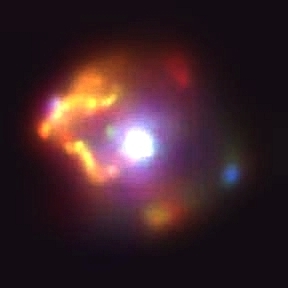
 Supernova Remnant. This supernova remnant (SNR 0540-63.3) by Chandra X-Ray Observatory is finely showing what a supernova event is triggering. Seen here is a neutron star (bright violet object, center) and an expanding shock-wave (orange). These are the two elements of any supernova explosion. A supernova (type II) is a a star having exhausted it nuclear fuel. Its core collapses in less than one second forming a neutron star, or a black hole. Remaining star material falls upon, temperatures are rising up to billion degrees, and a tremendous explosion is yielded, as matter is expelled back under the form of a thermonuclear shock. Such explosions may be as intense as ten billion Suns! A shock-wave then pushes forwards and illuminates material, building a shell of expanding gas. Supernovae are thought to be important actors in Universe evolution as they are producing heavy elements and carving surrounding gas clouds. Heavy elements are building blocks for planets and life as carved bubbles are an important factor to star formation: gas clouds instability leads to collapse and initiates stellar processes. picture courtesy NASA/CXC/SAO
Website Manager: G. Guichard, site 'Amateur Astronomy,' http://stars5.6te.net. Page Editor: G. Guichard. last edited: 12/28/2010. contact us at ggwebsites@outlook.com
Supernova Remnant. This supernova remnant (SNR 0540-63.3) by Chandra X-Ray Observatory is finely showing what a supernova event is triggering. Seen here is a neutron star (bright violet object, center) and an expanding shock-wave (orange). These are the two elements of any supernova explosion. A supernova (type II) is a a star having exhausted it nuclear fuel. Its core collapses in less than one second forming a neutron star, or a black hole. Remaining star material falls upon, temperatures are rising up to billion degrees, and a tremendous explosion is yielded, as matter is expelled back under the form of a thermonuclear shock. Such explosions may be as intense as ten billion Suns! A shock-wave then pushes forwards and illuminates material, building a shell of expanding gas. Supernovae are thought to be important actors in Universe evolution as they are producing heavy elements and carving surrounding gas clouds. Heavy elements are building blocks for planets and life as carved bubbles are an important factor to star formation: gas clouds instability leads to collapse and initiates stellar processes. picture courtesy NASA/CXC/SAO
Website Manager: G. Guichard, site 'Amateur Astronomy,' http://stars5.6te.net. Page Editor: G. Guichard. last edited: 12/28/2010. contact us at ggwebsites@outlook.com

